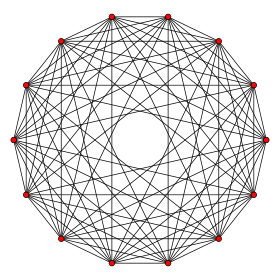| Regular 7-orthoplex (heptacross) | |
|---|---|
 Orthogonal projection inside Petrie polygon | |
| Type | Regular 7-polytope |
| Family | orthoplex |
| Schläfli symbol | {35,4} {3,3,3,3,31,1} |
| Coxeter-Dynkin diagrams | |
| 6-faces | 128 {35} |
| 5-faces | 448 {34} |
| 4-faces | 672 {33} |
| Cells | 560 {3,3} |
| Faces | 280 {3} |
| Edges | 84 |
| Vertices | 14 |
| Vertex figure | 6-orthoplex |
| Petrie polygon | tetradecagon |
| Coxeter groups | C7, [3,3,3,3,3,4] D7, [34,1,1] |
| Dual | 7-cube |
| Properties | convex, Hanner polytope |
In geometry, a 7-orthoplex, or 7-cross polytope, is a regular 7-polytope with 14 vertices, 84 edges, 280 triangle faces, 560 tetrahedron cells, 672 5-cells 4-faces, 448 5-faces, and 128 6-faces.
It has two constructed forms, the first being regular with Schläfli symbol {35,4}, and the second with alternately labeled (checkerboarded) facets, with Schläfli symbol {3,3,3,3,31,1} or Coxeter symbol 411.
It is a part of an infinite family of polytopes, called cross-polytopes or orthoplexes. The dual polytope is the 7-hypercube, or hepteract.
Alternate names
edit- Heptacross, derived from combining the family name cross polytope with hept for seven (dimensions) in Greek.
- Hecatonicosoctaexon as a 128-facetted 7-polytope (polyexon).
As a configuration
editThis configuration matrix represents the 7-orthoplex. The rows and columns correspond to vertices, edges, faces, cells, 4-faces, 5-faces and 6-faces. The diagonal numbers say how many of each element occur in the whole 7-orthoplex. The nondiagonal numbers say how many of the column's element occur in or at the row's element.[1][2]
Images
edit| Coxeter plane | B7 / A6 | B6 / D7 | B5 / D6 / A4 |
|---|---|---|---|
| Graph | |||
| Dihedral symmetry | [14] | [12] | [10] |
| Coxeter plane | B4 / D5 | B3 / D4 / A2 | B2 / D3 |
| Graph | |||
| Dihedral symmetry | [8] | [6] | [4] |
| Coxeter plane | A5 | A3 | |
| Graph | |||
| Dihedral symmetry | [6] | [4] |
Construction
editThere are two Coxeter groups associated with the 7-orthoplex, one regular, dual of the hepteract with the C7 or [4,3,3,3,3,3] symmetry group, and a half symmetry with two copies of 6-simplex facets, alternating, with the D7 or [34,1,1] symmetry group. A lowest symmetry construction is based on a dual of a 7-orthotope, called a 7-fusil.
| Name | Coxeter diagram | Schläfli symbol | Symmetry | Order | Vertex figure |
|---|---|---|---|---|---|
| regular 7-orthoplex | {3,3,3,3,3,4} | [3,3,3,3,3,4] | 645120 | ||
| Quasiregular 7-orthoplex | {3,3,3,3,31,1} | [3,3,3,3,31,1] | 322560 | ||
| 7-fusil | 7{} | [26] | 128 |
Cartesian coordinates
editCartesian coordinates for the vertices of a 7-orthoplex, centered at the origin are
- (±1,0,0,0,0,0,0), (0,±1,0,0,0,0,0), (0,0,±1,0,0,0,0), (0,0,0,±1,0,0,0), (0,0,0,0,±1,0,0), (0,0,0,0,0,±1,0), (0,0,0,0,0,0,±1)
Every vertex pair is connected by an edge, except opposites.
See also
editReferences
edit- H.S.M. Coxeter:
- H.S.M. Coxeter, Regular Polytopes, 3rd Edition, Dover New York, 1973
- Kaleidoscopes: Selected Writings of H.S.M. Coxeter, edited by F. Arthur Sherk, Peter McMullen, Anthony C. Thompson, Asia Ivic Weiss, Wiley-Interscience Publication, 1995, ISBN 978-0-471-01003-6 [1]
- (Paper 22) H.S.M. Coxeter, Regular and Semi Regular Polytopes I, [Math. Zeit. 46 (1940) 380–407, MR 2,10]
- (Paper 23) H.S.M. Coxeter, Regular and Semi-Regular Polytopes II, [Math. Zeit. 188 (1985) 559-591]
- (Paper 24) H.S.M. Coxeter, Regular and Semi-Regular Polytopes III, [Math. Zeit. 200 (1988) 3-45]
- Norman Johnson Uniform Polytopes, Manuscript (1991)
- N.W. Johnson: The Theory of Uniform Polytopes and Honeycombs, Ph.D. (1966)
- Klitzing, Richard. "7D uniform polytopes (polyexa) x3o3o3o3o3o4o - zee".
External links
edit- Olshevsky, George. "Cross polytope". Glossary for Hyperspace. Archived from the original on 4 February 2007.
- Polytopes of Various Dimensions
- Multi-dimensional Glossary